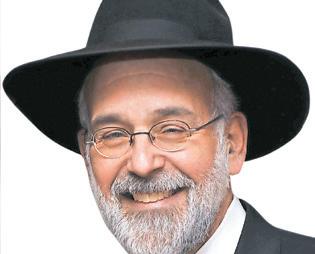BLOOD LIBELS
From matzah to rats to ‘Nosfenyahou’
cAROlINE GLIck
Israel Hayom

According to Canada’s La Presse, Israeli Prime Minister Benjamin Netanyahu is a vampire, and he is poised to suck the life out of the Palestinians in Rafah, Hamas’ final outpost in southern Gaza.
The newspaper that was once a paper of record in Canada ran a cartoon on March 20 (a piece of which is pictured at right) portraying Netanyahu as a vampire, with a huge hooked nose, pointy ears and claws for fingers, dressed in Dracula’s overcoat while standing on the deck of a pirate ship.
The caption, written in blood-dripping red letters, read: “Nosfenyahou: En Route Vers
Rafah.” Nosferatu, the Romanian word for vampire, was the title of a proto-Nazi German silent horror film from 1922 chock-full of antisemitic poison. The film, which became something of a cult flick, featured a vampire with a long Jewish nose. He arrived at an idyllic German town with a box full of plague-carrying rats that he released on the innocent villagers as he plotted to suck his realtor’s blood.
La Presse’s cartoon didn’t leave any room for imagination.
It wasn’t making a political or military argument against Israel’s planned ground operation in Rafah. Its goal wasn’t to persuade anyone of anything.
The Netanyahu-the-vampire cartoon asserted simply that Netanyahu is a Jewish bloodsucker and, more broadly, the Jewish state — and Jews worldwide — must be vigorously opposed
See Blood libels on page 21


The tale I’m about to tell started out as a feelgood movie of the week and ended up as a two-hanky tearjerker of bitterness and betrayal. From solidarity to the nearly unsalvageable, within a matter of decades.
I’m talking about the once unshakable bond between blacks and Jews, which is now about as solid as quicksand within a desert of separation — with some of the most recent enmity revolving around events in the Middle East.
But Israel’s war in Gaza is not the sole rift. Old antisemitic canards have been resurrected and shamefully adopted by some African-Americans. Recently,

and Westchester urged that a mural honoring notorious antisemite Louis Farrakhan should remain untouched. (Farrakhan has referred to Jews as “termites” and called Judaism “the synagogue of Satan.”) Just last month Farrakhan promised an adoring audience that Allah had told him, personally, that the genocide of the Jews is near.
(See “Bowman flips just a bit” on page 2.)
Last week, African-American conservative provocateur Candace Owens was fired from the Daily Wire after a series of remarks accusing Israel of genocide, referring to a “sinister gang of Jews” who control Hollywood, and liking a tweet that referred to a rabbi as being “drunk on Christian blood.” Bowman and Owens share nothing in common politically. They are simply African-Americans who hate Jews without ideology getting in the way.
Over the past several years, antisemitic sluices have surged, and influential African-Americans can’t stop libeling Jews. One of the four
See Black, blue, betrayed on page 2
March 29, 2024 19 Adar II, 5784 • Tzav / Shabbat Parah • Vol 23, No 12 TheJewishStar.com Publisher@TheJewishStar.com • 516-622-7461
latest trigger as Black Americans continue to turn against their Jewish allies
Rep. Jamaal Bowman of the Bronx
Gaza
A cartoon in “La Presse” depicts Benjamin Netanyahu as the character in the 1922 film “Nosferatu (Vampire),” a German silent horror film from 1922 chock-full of antisemitic poison. Screenshot
Black and blue and betrayed all over We Stand With Israel • Display your solidarity with poster inside NY’s Trusted Jewish Newspaper • Honest Reporting, Torah-True At 1963 March on Washington, MLK Jr. is upfront near Rabbi Joachim Prinz. Center for Jewish History NYC
THANE ROSENBAUM
Distinguished University Professor Touro College


I W A S V E R Y




Bowman flips just a bit on his 10/7 denialism
One of Israel’s most implacable foes in Congress — Rep. Jamaal Bowman of the Bronx and Westchester — slightly reversed his view that not only was Israel to blame for Oct. 7 but that the terrible things reported to have happened on that day never happened.
“There was propaganda used in the beginning of the siege,” Bowman told a Nov. 17 rally of proHamas protesters in Westchester. “There’s still no evidence of beheaded babies or raped women. But they still keep using that lie [for] propaganda.”
Last Thursday outside the House floor, Bowman declined to answer Politico questions, saying, “I’m focused on my votes. … I’m not talking,” he said.

One of our latest reviews:
"I must say: I was very impressed entering this building The lady at the front desk was pleasant When I arrived on the six floor, the first thing I've noticed was a freshness in the air The nurses were nice and the residence looked clean My Aunty s room was beautiful and clean They made her as comfortable as possible I would truly recommend this rehabilitation home " - TM, Long Island
New look. Same care.
85% Private Rooms
Separate Kitchens for Meat + Dairy (Cholov Yisroel | VHQ)
Full time Rabbi On-Staff
Exclusive to Margaret Tietz:
Virtual Reality REAL Therapy System
Shabbos Minyanim
Full Holiday Schedule
Shabbos Hospitality Apartment
Special Holiday Meals
Beautiful Gardens
Shabbos Elevator
Community Eruv



In a written statement later, Bowman said, “The UN confirmed that Hamas committed rape and sexual violence, a reprehensible fact that I condemn entirely. I also voted yes on Resolution 966, which officially condemns the rape and sexual violence committed by Hamas. … I always stand against sexual violence in all forms and stand for peace for all.”
In the months since Bowman’s November remarks, evidence of the Oct. 7 rapes has grown substantially, and even many anti-Israel organizations and media have conceded they took place.
Bowman also has come under fire recently for past comments advancing conspiracy theories about the Sept. 11 attacks.
Black, blue, betrayed…
Continued from page 1
original organizers of the 2017 Women’s March, Tamika Mallory, caused the two Jewish co-founders to resign when she berated them for belonging to a people responsible for the slave trade.
In 2020, professional athletes DeShawn Jackson and Stephen Jackson took to Instagram to praise Adolf Hitler and Farrakhan. Actor Nick Cannon used his YouTube channel to accuse the Rothschild family of conspiring with Zionists to control world banking. Rapper Ice Cube promoted a cartoon of caricatured Jews playing Monopoly on the backs of black men.
In 2022, rapper Kanye West released a torrent of antisemitic greatest hits that Spotify would have rejected. He praised Hitler and the Nazis, called Black Hebrew Israelites the true Jews and threatened to go “death con 3 on JEWISH PEOPLE.” Basketball star Kyrie Irving endorsed a film that denied the Holocaust and claimed that Jews are lying about their biblical origins — and he did this while playing for Brooklyn!
Also in 2022, Whoopi Goldberg used her platform on “The View” to educate America that the Holocaust was not racially motivated. Obviously she adopted a Jewish surname, but not a Jewish brain.
Back in 2019, Hasidic Jews living in Williamsburg, Crown Heights, Borough Park, Monsey and Jersey City, became targets of African-American teenagers and Black Hebrew Israelites.
Stand-up comedian Dave Chappelle, in one of his recent shows, accused Israel of committing war crimes. There’s a history here.
In 2019, on Netflix, he made a joke about “Space Jews” that was an allegory for either Jewish power or Zionist “colonialism.” A year later, while hosting “Saturday Night Live,” he defended West and Irving by stating that Jews shouldn’t blame blacks for their past trauma. Who’s doing that? The blame is in promoting vile tropes and lies that foment antisemitic violence among young black males.
How did things get so bad, and so fast? The political alliance was once obvious on paper.
Today it is paper thin, a relationship best defined by mutual suspicion and grievance. The condition of African-American and Jewish relations in the United States today is no longer a matter of black and white — or even a noncommittal shade of gray. It is best described as black and blue.
It began with the best of intentions; two peoples inexorably drawn together by a history of persecution.

718-298-7806
164-11 Chapin Parkway, Jamaica Hills, NY 11432
Jews helped found both the NAACP and its Legal Defense Fund. When Thurgood Marshall, who directed the latter, was appointed to the federal bench, he anointed Jack Greenberg as his successor. A Jewish lawyer defended the Scottsboro Boys, pro bono. Half the Freedom Riders were white, and 50% of those were Jewish. Two of the three murdered civil rights workers in Mississippi were Jews. Rabbi Abraham Joshua Heschel linked arms with Martin Luther King Jr. throughout the Deep South. One of King’s closest confidants was attorney Stanley Levison.
Not long after King’s assassination, AfricanAmericans came to resent the perceived sanctimony of Jewish paternalism; Jews who had
With rising incitement against Jews globally, American Jews are feeling betrayed by former allies — those who are outspokenly antisemitic, and those who remain silent.
placed their bodies on the line sensed ingratitude.
Eventually, Black Power led to Jewish exclusion. Malcolm X shattered the moral foundations of King’s passive nonviolent resistance with highoctane militancy. A once peaceful movement morphed into urban riots.
Over the ensuing decades, Jewish economic success robbed Jews of their underdog, underclass status. African-Americans made great progress, too, but powerful forces found it politically expedient to remain stuck in the grievances of 1960s.
Meanwhile, Israel and the memory of the Holocaust became ethnic priorities for Jews that didn’t align with an African-American agenda. Palestinians were anointed as successors to the civil rights struggle, even though their methods, which depended on terrorism, had nothing in common with the marches and sit-ins perfected by King. And the Holocaust seemed like special pleading for a people who were doing just fine.
These tensions reached a crescendo with the death of George Floyd, the rise of Black Lives Matter and Israel’s war in Gaza. Suddenly, it became fashionably convenient to forget the Jewish contribution to civil rights — if it was remembered at all. Allegations of apartheid and genocide, inveighed against Israel, went unrebutted.
African-Americans were color-blind to the Instagram postings of Ethiopian Israelis fighting for the Israel Defense Forces, or a black former Miss Israel calling for the return of the hostages.
Nothing was allowed to exonerate the Jewish state.
That’s why so many within the Congressional Black Caucus and the Squad are in lockstep when it comes to condemning Israel. And it’s what makes African-American leaders who support Israel, like South Carolina Republican Sen. Tim Scott and Democratic Reps. Hakeem Jeffries of Brooklyn and Richie Torres of the Bronx, exceptional outliers.
With rising incitement against Jews globally, American Jews are feeling betrayed by former allies — those who are outspokenly antisemitic and those who remain silent. Polarization of this magnitude has caused Jews to remain silent, too.
That’s understandable. The acronyms BLM, BDS, DEI and CRT are unassailable in this political culture. Faced with such a winning combination of race cards, Jews are likely to fold.
March 29, 2024 • 19 Adar II 5784 THE JEWISH STAR 2
• margarettietz
org
1248781





We
THE JEWISH STAR March 29, 2024 • 19 Adar II 5784 3 WHAT'S IN STORE THIS WEEK? EVERYTHING!
7am-8pm / WED: 7am-10pm
7am-11pm FRI: 7am-2 hours before Shabbos SAVINGS PLAZA 11 Lawrence Lane Lawrence, NY 11559 516.371.6200 info@kolsavemarket.com @kolsavemarket
SUN-TUES:
THURS:
want to thank our incredible community of
our best
express our
our service, prices and variety
To Our Valued Customers, LIEBER'S Potato Starch Yellow Bag YUMMY American Cheese Singles 3.5 lbs • 100 Slices Pastrami Second Cut Brisket $0.89 $12.99 $6.99 /lb SNEAK PEEK BLOWOUT March 31 - April 5 BOWL & BASKET Seltzer (all flavors) 12/1 Liter • By the case only Kosher for Passover $4.99
KolSave shoppers for
Purim season yet! To
sincerest hakoras hatov, we are constantly looking for ways to improve
of options. We appreciate your loyalty and look forward to continuing to serve you.
Proudly Jewish.

Proudly Zionist.
Proudly American.
March 29, 2024 • 19 Adar II 5784 THE JEWISH STAR 4 1216059











































THE JEWISH STAR March 29, 2024 • 19 Adar II 5784 5 1250129
WINE AND DINE
How lox became quintessential Jewish dish
EthEl G. hofmAN

It’s the American Jewish classic that goes way beyond Sunday-morning breakfasts with the whole mishpacha. Lox and bagels with a schmear of cream cheese has become a universal staple for breakfast, brunch or even as a takealong snack.
Who can resist? It’s available everywhere. There’s no need anymore for a stop at the local deli or a call to the caterer to purchase it. Supermarkets have fresh lox or lox packaged as smoked salmon in multiple flavors and sizes, from a few ounces to a mega-pack, in chunks or sliced thinly, which is ideal for a crowd.
Brooklyn-based Acme Smoked Fish Corporation (not to be confused with Acme supermarkets) is the largest producer of smoked salmon in the United States. A privately held, family-owned company, Acme has facilities throughout America, as well as international locations in Chile and Denmark.
According to Ellen Lee-Allen, Acme senior marketing manager, the best quality fish used may be sourced from all over the world — wild from Alaska, farmed from Norway, Chile and elsewhere.
For Eastern European Jews, it was herring salted to last through the winter.
Many think of lox as a Jewish staple, but the preparation has its origins in Scandinavia and it wasn’t always the silky, buttery-cured salmon found nearly everywhere today. The traditional curing method was using a salty brine, not smoking the fish.
It was only in the early 1900s when Jews immigrated to the United States and found salmon cheaper than herring, that lox (from the Yiddish laks) became popular.
Fish is considered pareve, and so for new immigrants, salmon could be bought from a nonkosher market. But what really popularized lox throughout America was the Transcontinental Railroad, which transported salted salmon from the Pacific coast to other parts of the country, including New York.
Lox and smoked salmon are often used interchangeably, but they’re not the same. Lox or gravlax is the Scandinavian method of preparing salmon, preserved by covering it with a salt mixture or brined in salt water for several days. Then it can be thinly sliced and appears translucent

with a mild fish flavor. It is never smoked.
As in the recipe below shared by the late Sima Radowitz, fresh dill added to the dry salt mixture is what sets it apart in flavor. And preparing at home, you can’t beat the price.
Nova is cured in a milder brine and then coldsmoked, which happens over an 18-hour stretch at between 70 and 75 degrees. It’s less salty with a mild smoky flavor.
During World War II, when salmon was hard to get, it was brought in from Nova Scotia — and the name Nova stuck.
These days, smoked salmon is available flavored with seasonings such as pastrami spices and, for the non-purist, Toragashi-flavored with a Japanese 7-spice. Scottish-style is double-smoked for a more intense flavor. Then, of course, there’s kippered and baked salmon, usually packaged in four-ounce portions. Smokehouse temperatures stay between 150 and 160 degrees (low enough to preserve the salmon’s moist texture and high enough to produce a tender flakiness).
Besides lox on a bagel, the delicate fish has helped transform non-kosher dishes into kosher delicacies. Take eggs Benedict, which became wildly popular in New York in the 1930s. Kosher-keeping Jews couldn’t eat the ham, so smoked salmon was substituted into the dish and cream cheese was switched for the Hollandaise — then presto, eggs Benjamin became a tasty kosher version.

For the bread, instead of English muffins, I use leftover toasted challah. The simple Hollandaise Sauce recipe below may be made pareve or dairy.
The crisp topping for Spinach and Smoked Salmon Pie is phyllo dough, my way. Simply crumble sheets of phyllo over the spinach mixture and drizzle with a little melted margarine before baking. No need to quickly brush each sheet with melted margarine to avoid breakage. Crumbling is easy, and baked off, looks and tastes even better!
Sima’s Gravlax (Pareve)
Makes 10 to 12 servings
Cook’s Tips: •Pull out any bones with tweezers. •As a weight, use a 5-pound bag of sugar or flour wrapped in a plastic bag. •May be refrigerated, wrapped tightly, for up to a week or frozen. Remove from freezer to fridge 24 hours before needed.
Ingredients:
• 1-1/2 lb. salmon fillet, boneless
• 3/4 cup kosher salt
• 1/4 cup sugar
• 1 bunch of fresh dill
Directions:
Rinse the salmon in cold water. Pat dry with paper towels. Set aside. In a small bowl, combine the salt and sugar.
Mix well. Set aside.
In a 3-quart casserole or shallow dish, spread one-half of the dill. Sprinkle with onehalf of the salt mixture.
Place the salmon, skin-side down, in the casserole. Cover with the remaining dill and salt mixture. Press firmly into the salmon’s surface. Wrap salmon tightly with parchment paper, then plastic wrap. Weigh down salmon in a casserole with a 5-pound weight. Refrigerate for two days, turning once.
Unwrap the fish and run it under cold water to thoroughly remove the dill and salt mixture. Pat dry. With a sharp knife, slice the salmon paperthin on the diagonal.
Ready to serve with bagels and cream cheese.
Eggs Benjamin (Pareve)
Serves 2
Cook’s Tips: •Substitute toasted crumpets or English muffins for challah. •Spread thinly with cream cheese before topping with remaining ingredients. •For Hollandaise sauce, butter or margarine must be very hot, or the mixture will not emulsify.
Ingredients:
• 2 slices toasted challah, about 3/4-inch thick
• 2 to 3 slices (about 2 oz.) smoked salmon
• 2 thin slices of sweet onion
• 2 slices tomato, about 1/4-inch thick
• 2 poached or fried eggs, cooked as you like it
• 2 tsp. capers (optional)
• Snipped parsley or paprika to garnish (optional)
• Hollandaise Sauce (recipe below)
Directions:
Place challah on a serving dish. Top each slice with smoked salmon, then onion, then tomato, capers, and a poached or fried egg. Spoon a dollop of Hollandaise Sauce over top. Garnish and serve immediately.
Hollandaise Sauce (Pareve or Dairy)
2 egg yolks
2 tsp. freshly squeezed lemon juice
1/2 tsp. Dijon-style mustard
Pinch each salt and white pepper
1/4 cup hot butter or margarine
Place the egg yolks, lemon juice, mustard, and salt and pepper in the blender jar. Whirl for 5 seconds. With the motor running, slowly pour in hot melted margarine or butter. The mixture will have thickened. Use as above.
See How lox became on page 8

March 29, 2024 • 19 Adar II 5784 THE JEWISH STAR 6
Lox on a plate.
on a bagel.
Tati, Pixabay Lox on toast. Matthew Osier, Pexels
White Session, Pixabay
Lox
Tante


THE JEWISH STAR March 29, 2024 • 19 Adar II 5784 7 THE STAR February 23, 2024 • 14 Adar I 5784 ^Pre-seasoned & unseasoned spatchcock (butterflied) chicken available at a Gourmet Glatt near you. CRISPY, JUICY SPATCHCOCK. JUST WHEN YOU THOUGHT ROAST CHICKEN COULDN’T GET ANY BETTER. SIGN UP HERE FOR SPECIALS Shop online at GourmetGlattOnline.com gourmetglatt cedarhurst 137 Spruce Street Cedarhurst, New York T: 516-569-2662 woodmere 1030 Railroad Ave Woodmere, New York T: 516-295-6901 brooklyn 1274 39th Street Brooklyn, New York T: 718-437-3000 lakewood north 1700 Madison Avenue Lakewood, New Jersey T: 732-961-1700 lakewood south 1328 River Avenue Lakewood, New Jersey T: 732-961-1750
Crusted Spinach and Smoked Salmon Pie (Pareve)
Serves 6 to 8
Cook’s Tips: • Trim leeks to leave 1 to 2 inches of green stem. Slice and wash in cold salted water to remove any sand or debris. Rinse in cold water. • Substitute butter instead of margarine to make dairy. • If you can only buy 2 leeks in a bunch, clean, slice and freeze half. Defrost before using in soups or another casserole.
Ingredients:
• 2 Tbsp. olive oil
• 1 medium onion, coarsely chopped
• 1 leek, trimmed, cleaned and thinly sliced
• 1 small red pepper, seeded and diced
• 1 (16-oz.) package of frozen chopped spinach, thawed, squeezed dry
• 1 bunch (about 2 cups loosely packed) parsley, snipped coarsely
• 4 eggs, lightly beaten
• 2 Tbsp. matzah meal
• 4 ounces hot smoked baked salmon, flaked
• 1/2 tsp. each of salt and freshly ground pepper or to taste
• 1/4 tsp. nutmeg
• 3 to 4 sheets of phyllo dough
• 2 Tbsp. margarine, melted
Directions:
Preheat oven to 400 degrees. Spray an 8x8inch baking dish with nonstick baking spray. In a large pot, heat the oil over medium heat. Add the onion, leek and red pepper. Sauté over medium-low heat until softened, 8 to 10 minutes. Set aside for 5 minutes.
Stir in the remaining ingredients except the phyllo dough and margarine. Transfer the spinach mixture to the prepared baking dish.
Coarsely crumble the phyllo dough over and drizzle with melted margarine.
Bake in preheated oven for 30 minutes. Phyllo should be nicely browned. Serve hot or at room temperature.

Nova Enchiladas (Pareve)
Serves 4
Cook’s Tips: •Enchilada sauce is a chili-based sauce; may be substituted with a mild salsa instead. •Cut smoked salmon with scissors. •Brush avocado with lemon juice to avoid browning.
Ingredients:
• 1 Tbsp. vegetable oil
• 1/2 small onion, chopped coarsely
• 1/4 tsp. bottled minced garlic

• 1 small green zucchini, coarsely chopped
• 2 cups canned corn, drained well
• 1 (15-oz.) can black beans, drained well
• 2 to 3 ounces of smoked salmon, cut into short strips
• 2 Tbsp. lime or lemon juice
• 2 tsp. cumin or to taste
• 1-1/4 cups canned enchilada sauce
• 8 corn tortillas
• 1 cup seasoned panko
For garnish: 8 to 10 cherry tomatoes, quartered 1 avocado, cut in wedges.
Directions:
Preheat oven to 350 degrees. In a large skillet, heat the oil over medium heat. Add the
onion, garlic and zucchini. Cook until onion is softened.
Stir in the corn, beans, salmon, lime or lemon juice, cumin and about 1/4 cup enchilada sauce, or just enough to moisten.
Pour half of the remaining sauce into a 9x13 baking dish. Spread thinly. Place a large scoop of vegetable mixture into the center of each tortilla. Roll up tightly.
Arrange in one layer in the prepared baking dish. Drizzle with the remaining sauce and sprinkle panko over top.
Bake in preheated oven until heated through. Serve hot garnished with tomatoes and avocados.















































How lox became quintessential Jewish dish… Continued from page 6
Crusted Spinach Salmon Pie.
Ethel G. Hofman
Nova Enchiladas.
March 29, 2024 • 19 Adar II 5784 THE JEWISH STAR 8 • Quality printing • Full-service excellence • Reliable mailing • Unrivaled customer service • Fast turnaround • Innovative solutions Elevate your business communication with PRINTING RICHNER and MAILING SERVICES LLC Michael Karff Senior Sales Executive 516-569-4000 (#288) mkarff@richnerprinting.com 2 Endo Blvd, Garden City Where Excellence Meets Efficiency! FAMILY OWNEDfor 60 YEARS 1247277 ONE-STOP PRINTING SOLUTION! WE MAKE LASTING IMPRESSIONS
Pixabay









THE JEWISH STAR March 29, 2024 • 19 Adar II 5784 9 1249532




1247009 March 29, 2024 • 19 Adar II 5784 THE JEWISH STAR 10 1248710 1209448 1218804 Help get the news out! DRIVERS WANTED Deliver newspapers (The Jewish Star and others) to stores and buildings in Nassau, Queens and Riverdale. Excellent income opportunity. Work hours on Wednesdays and Thursdays, with possible additional assignments. Must have suitable vehicle, clean license. 516-622-7461 x291 • Publisher@TheJewishStar.com
The Best on
Nassau County’s South Shore.
Three Years in a Row.
High Performing in Ten Areas of Care
THE JEWISH STAR March 29, 2024 • 19 Adar II 5784 11
1248759
mountsinai.org/southnassau

We
TheJewishStar.com
stand with Israel.

1233304

Your Jewish Star workplace can be almost anywhere. Long Island, NYC, Starbucks.
Where you work is less important than what you accomplish.
Our editorial and marketing positions are hybrid, allowing tremendous flexibility.
You can make a great impact on New York’s Orthodox communities from your local park, or Starbucks,
or your home office, as well as at our workplaces in Garden City and Riverdale where our teams collaborate and inspire each other.
So don’t be put off by a ride on the LIRR, MetroNorth or the #1, or by traffic on the LIE or the GWB.
If a Jewish Star position calls out to you, you owe it to yourself to call back.
Enjoy working for a media company devoted to honest journalism, whose goals are Torah-true, and where all Jewish holidays are observed.
Email your inquires and expressions of interest to Publisher Ed Weintrob: EWeintrob@TheJewishStar.com
March 29, 2024 • 19 Adar II 5784 THE JEWISH STAR 14
1252045



THE JEWISH STAR March 29, 2024 • 19 Adar II 5784 15 PARKER CARE. THE BEST. FOR THE BEST. Post-Acute Care | Sub-Acute Care | Short-Term Rehabilitation | Long Term Care | Hospice Palliative Care | Inpatient/Outpatient Dialysis | Home Health Care | Medical House Calls Senior Care Management 271-11 76th Avenue New Hyde Park, NY 11040 I 877-727-5373 I parkerinstitute.org 1243624
jewish star torah columnists:
•Rabbi Avi Billet of Anshei Chesed, Boynton Beach, FL, mohel and Five Towns native •Rabbi David Etengoff of Magen David Yeshivah, Brooklyn
•Rabbi Binny Freedman, rosh yeshiva of Orayta, Jerusalem
contributing writers:
•Rabbi Sir Jonathan Sacks zt”l,
former chief rabbi of United Hebrew Congregations of the British Commonwealth •Rabbi Dr. Tzvi Hersh
Weinreb, OU executive VP emeritus
•Rabbi Raymond Apple, emeritus rabbi, Great Synagogue of Sydney •Rabbi Yossy Goldman, life rabbi emeritus, Sydenham Shul, Johannesburg and president of the South African Rabbinical Association.
contact our columnists at: Publisher@TheJewishStar.com
Five towns candlelighting: From the White Shul, Far Rockaway, NY
Fri March 29 / 19 Adar II
Parah • Tzav
Candles: 6:59 • Havdalah: 8:09
Fri April 6 / 26 Adar II
Shmini • Shabbas Mevarchim
Candles: 7:06 • Havdalah: 8:16
Fri April 12 / Nisan 4
Tazria
Candles: 7:13 • Havdalah: 8:23
Fri April 19 / Nisan 11
Shabbos HaGadol •Metzora
Candles: 7:21 • Havdalah: 8:31
Mon April 22 / Nisan 14
Erev Pesach • First Seder
Candles: 7:24
Fri April 26 / Nisan 18
Shabbos Chol Hamoed
Candles: 7:28 • Havdalah: 8:38
Facing up to the reasons civilizations die
rabbi sir jonathan sacks zt”l

In “The Watchman’s Rattle,” subtitled “Thinking Our Way Out of Extinction,” Rebecca Costa delivers a fascinating account of how civilizations die. When their problems become too complex, societies reach what she calls a cognitive threshold. They simply can’t chart a path from the present to the future.
The example she gives is the Mayans. For a period of three and a half thousand years, between 2,600 BCE and 900 CE, they developed an extraordinary civilization, spreading over what is today Mexico, Guatemala, Honduras, El Salvador, and Belize, with an estimated population of 15 million people.
Not only were they expert potters, weavers, architects, and farmers, they also developed an intricate cylindrical calendar system, with celestial charts to track the movements of the stars and predict weather patterns.
They had their own unique form of writing as well as an advanced mathematical system. Most impressively they developed a water-supply infrastructure involving a complex network of reservoirs, canals, dams, and levees.
Then suddenly, for reasons we still don’t fully understand, the entire system collapsed. Sometime between the middle of the eighth and ninth century the majority of the Mayan people simply disappeared. There have been many theories as to why it happened. It may have been a prolonged drought, overpopulation, internecine wars, a devastating epidemic, food shortages, or a combination of these and other factors. One way or another, having survived for 35 centuries, Mayan civilization failed and became extinct.
Rebecca Costa’s argument is that whatever the causes, the Mayan collapse, like the fall of the Roman Empire, and the Khmer Empire of thirteenth century Cambodia, occurred because problems became too many and complicated for the people of that time and place to solve. There was cognitive overload, and systems broke down.
It can happen to any civilization. It may, she says, be happening to ours. The first sign of breakdown is gridlock. Instead of dealing with what everyone can see are major problems,
Jews did not abandon the past, but they did not cling to the past. Nor did they take refuge in irrationality.
people continue as usual and simply pass their problems on to the next generation.
The second sign is a retreat into irrationality. Since people can no longer cope with the facts, they take refuge in religious consolations. The Mayans took to offering sacrifices.
Archaeologists have uncovered gruesome evidence of human sacrifice on a vast scale. It seems that, unable to solve their problems rationally, the Mayans focused on placating the Gods by manically making offerings to them. So apparently did the Khmer.
Which makes the case of Jews and Judaism fascinating. They faced two centuries of crisis under Roman rule between Pompey’s conquest in 63 BCE and the collapse of the Bar Kochba rebellion in 135 CE. They were hopelessly factionalised. Long before the Great Rebellion against Rome and the destruction of the Second Temple, Jews were expecting some major cataclysm.

he brought a pure oblation. Yerushlami, Perek 5 Halachah 1
What is remarkable is that they did not focus obsessively on sacrifices, like the Mayans and the Khmer. With their Temple destroyed, they instead focused on finding substitutes for sacrifice.
•One was gemillat chassadim, acts of kindness. Rabban Yochanan ben Zakai comforted Rabbi Joshua, who wondered how Israel would atone for its sins without sacrifices, with the words:
“My son, we have another atonement as effective as this: acts of kindness, as it is written (Hosea 6:6), ‘I desire kindness and not sacrifice’.” Avot deRabbi Natan 8
•Another was Torah study. The Sages interpreted Malachi’s words, “In every place offerings are presented to My name,” to refer to scholars who study the laws of sacrifice. (Menachot 100a).
“One who recites the order of sacrifices is as if he had brought them” (Taanit 27b). Malachi 1:11
•Another was prayer. Hosea said, “Take words with you and return to the L-rd. … We will offer our lips as sacrifices of bulls” (Hos. 14:2-3), implying that words could take the place of sacrifice.
He who prays in the house of prayer is as if
•Yet another was teshuvah. The Psalm (51:19) says “the sacrifices of G-d are a contrite spirit.” From this the Sages inferred that “if a person repents it is accounted to him as if he had gone up to Jerusalem and built the Temple and the altar and offered on it all the sacrifices ordained in the Torah” (Vayikra Rabbah 7:2).
•A fifth approach was fasting. Since going without food diminished a person’s fat and blood, it counted as a substitute for the fat and blood of a sacrifice (Brachot 17a).
•A sixth was hospitality. “As long as the Temple stood, the altar atoned for Israel, but now a person’s table atones for him” (Brachot 55a). And so on.
What is striking in hindsight is how, rather than clinging obsessively to the past, leaders like Rabban Yochanan ben Zakai thought forward to a worst-case-scenario future. The great question raised by parshat Tzav, which is all about different kinds of sacrifice, is not “Why were sacrifices commanded in the first place?” but rather, “Given how central they were to the religious life of Israel in Temple times, how did Judaism survive without them?”
The short answer is that overwhelmingly the Prophets, the Sages, and the Jewish thinkers of the Middle Ages realised that sacrifices were symbolic enactments of processes of mind,
heart, and deed, that could be expressed in other ways as well. We can encounter the will of G-d by Torah study, engaging in the service of G-d by prayer, making financial sacrifice by charity, creating sacred fellowship by hospitality, and so on.
Jews did not abandon the past. We still refer constantly to the sacrifices in our prayers. But they did not cling to the past. Nor did they take refuge in irrationality. They thought through the future and created institutions like the synagogue, house of study, and school. These could be built anywhere, and would sustain Jewish identity even in the most adverse conditions.
That is no small achievement. The world’s greatest civilizations have all, in time, become extinct while Judaism has always survived. In one sense that was surely Divine Providence. But in another it was the foresight of people like Rabban Yochanan ben Zakai who resisted cognitive breakdown, created solutions today for the problems of tomorrow, who did not seek refuge in the irrational, and who quietly built the Jewish future.
Surely there is a lesson here for the Jewish people today: Plan generations ahead. Think at least 25 years into the future. Contemplate worst-case scenarios.
Ask “What we would do, if…” What saved the Jewish people was their ability, despite their deep and abiding faith, never to let go of rational thought, and despite their loyalty to the past, to keep planning for the future.
March 29, 2024 • 19 Adar II 5784 THE JEWISH STAR 16
תבש לש בכוכ
Merging worldly skills with a mystical essence
Rabbi DR. tzvi heRsh weinReb
Orthodox Union

The world did not know that he was a mystic. He was an accomplished diplomat, who knew how to deal with people in positions of great power. Some characterized him as a shrewd, and even manipulative, manager of men. His name was Dag Hammarskjold, and he was the second SecretaryGeneral of the United Nations.
He died in an airplane crash in September of 1961 and was posthumously awarded the Nobel Peace Prize. It was as an astute and
successful politician that the world knew him. It was only after his tragic and untimely death that his personal journal was discovered. It was subsequently published under the title “Markings,” and it revealed a rare depth of introspection, which some described as poetic, whereas others saw in it poignant expressions of mystical experiences.
For me, Hammarskjold was but a twentieth-century example of my own favorite type of hero, the person who combines worldly skills with a private spiritual essence. He was a man who lived in the world of action, dealing with the obstinate problems of international relations, but he drew his inspiration from sources within his innermost being.
The Jewish biblical tradition knows of quite a few heroes of this type — men who
were engaged in the affairs of the world, but also in touch with the deep wellsprings of their souls. Surely, the Patriarch Abraham was one such person, and King David was clearly another.
Another twentieth-century example of an individual who could harmonize his profound inner inspiration with the demands of life as a public figure was Rabbi Abraham Isaac Kook, the first chief Rabbi of the Land of Israel, of whom I have written frequently in this weekly column. He too was characterized by many as a mystic, and indeed his written works testify to his mystical bent. But he was engaged in public affairs in an era of history which demanded political acumen, diplomatic skill, and the courage to act upon religious and nationalistic convictions.
Rav Kook’s commentary on a passage in this week’s Torah portion, Tzav (Leviticus 6:1-8:36), offers a creative analysis of the symbolism of the Temple sacrifices which illustrates the combination of inner inspiration and outer action which I find so fascinating, so rare, and so very necessary.
At the beginning of the parsha, we read of the olah offering, the olah being that sacrifice which was totally consumed by the fire upon the altar. As we read the details of this offering, we learned that its service involved three different locations, with descending sanctity:
1. Upon the altar, of which we read, “It is burned upon the altar all night until morning, while the fire on the altar is kept going on it” (Leviticus 6:2).
See Weinreb on page 22
Karet: Whose choice, and on whose judgment?

Whenever I come across the word “v’nikhrita” (and he/she/they will be cut off from the Jewish people) in the Torah, I marvel over where such a notion stands in the 21st century world. While once upon a time people really cared about what the Torah says, I find more and more that people care about what others think of what they do.
The concept of karet can be simply summarized in this manner: there are two positive
commandments in the Torah that are so important that people who opt out of them are considered to have opted out of the entire religion. They are bris milah and the korban pesach.
Along similar lines, there are negative commandments so important that should one violate them, one is also “opting out of Judaism.” [I recognize that “opting out” is not the same as “being cut off spiritually from one’s people” (the literal meaning of the term). But I think the “opt out” is a little more appealing than the excision.]
Karet is a punishment placed like a price on one’s head, in theory. G-d tries you and convicts you, and He’ll get you in the way He feels is right, in the proper way and in the right time.
In Vayikra 7:20-21, the Torah presents some
of the rules related to how individuals would go about eating the peace offerings they had brought: “But if any person eats the flesh of a peace sacrifice to G-d while still in a state of spiritual impurity, his soul will be cut off from his people. Any person who comes in contact with human (spiritual) impurity, or with an impure mammal or other impure creature, and then eats the flesh of a peace offering to G-d, shall have his soul cut off from his people.”
The concepts of spiritual impurity and purity (tumah and taharah) are largely monitored by each individual. I know when I am tameh because I know where I have been and what I have done. You know when you are tameh for your own reasons. This status is something others “might” be aware of, but it does not have to
be something that becomes public knowledge. Obviously nothing is beyond G-d, so as He is the one who imposes the karet, He is the one keeping tabs on our personal status.
Iwonder if a person would really push the envelope. Knowing of one’s own “tumah status,” was there a person who said, “I don’t care about karet. I want to partake of the meat of the peace offering?” Could such a decision transpire and be acted upon?
In these days when people are preparing for the holiday of Pesach (Passover), I marvel over how many people pay so much attention to the karet concerns of this holiday. Shmot 12:15,19 speaks of how those who eat chametz during the holiday will get karet — they are opting out of being
See Billet on page 22
Purim to Pesach with a stop at the Golden Calf

Purim is now behind us and the next time we are going to witness a full moon is exactly one month from now, Pesach. With that exciting thought in mind, I was taken by an essay by Dr. Adele Berlin in her work, “The JPS Commentary: Esther” (Jewish Publication Society, 2001) wherein she details the thematic and historical link between the Exodus and the Book of Esther. Please consider these details as narrated by Dr. Berlin and compare them to what you yourself learned of this in school.
“Passover is not mentioned in Esther. But Haman’s decree was promulgated on the 13th day of the first month [3:12] that is 13th of Nissan, just one day before the eve of Passover.
“Midrash Leqah Tov, in its comment on 4:17, dates Esther’s fast to the 13, 14, and 15 days of Nissan, thereby making the beginning of Passover a fast day. Ahasuerus’s sleepless night [6:1] was on ‘the night of watching’ [Exodus 12:42], that is, the night of the Exodus. And Haman was impaled on the 16 of Nissan, during Passover.”
Berlin continues:

“This tradition, which occurs in bits and piec-
es in other midrashim, is perhaps most familiar from references in piyyutim at the end of the seder: ‘Az rov nissim,’ by Yanai, mentions that among the events that happened on the night of Passover was the writing of Haman’s edict and the king’s sleepless night.”
“Later generations linked Pharaoh and Haman together with later tyrants who sought to harm the Jews. The famous SpanishJewish poet Yehudah Halevi drew an analogy between the escape of the Israelites at the Red Sea and the Purim story in his poem, ‘adon hasdekha bal yehdal,’ which was incorporated into the morning service in the Sephardic liturgy on the morn-
ing preceding Purim. Indeed, Midrash Leqah Tov says, ‘The month during which miracles were performed for our fathers, in Egypt, at the sea, and at the Jordan.’ Clearly, in rabbinic tradition, the deliverance of the Jews in the Book of Esther is seen in terms of the deliverance of the Jews from Egypt.”
As we move on to our preparations for Pesach we should be mindful of Dr. Berlin’s timely teachings that link the holidays of Purim and Pesach within the tradition of our quest for freedom and divine salvation as demonstrated by both these holidays.
This coming Shabbat we again read and learn of that sad chapter in our history concerning the Golden Calf. In addition to this episode, we also have the readings concerning
‘Ledoros’: Commandments for all generations

Like much of sefer Vayikra, our parasha, Tzav, focuses on the korbanot. Accordingly, the second verse presents the mitzvah of the korban olah:
“Command (tzav) Aharon and his sons, saying, ‘This is the law of the burnt offering: That is the burnt offering which burns on the altar all night until morning, and the fire of the altar shall burn with it’.”
Rashi, basing himself on Midrash Sifra on our verse and Talmud Bavli, Kiddushin 29a, explains tzav in this manner: “The expression tzav always
denotes urging [to promptly and meticulously fulfill a particular commandment] for the present (miyad) and for future generations (v’ledorot).”
Rabbi Joseph B. Soloveitchik asks: “What is the meaning of the word ledoros (for future generations) in this context? The mitzvos of mezuzah, tefillin and Shabbos are clearly ledoros. Thousands of years have gone by, and these mitzvos are observed as they had been when they were originally given. But in what way are the mitzvos of the Mishkan practiced today? There has been no korban tamid [daily offering] for almost 2,000 years! In what sense does the mitzvah of offering korbanos continue?”
The Rav begins his answer by citing a midrashic passage that presents a fascinating dialogue between Hashem and Avraham Avinu: “Abraham asked how he was to know that G-d would not forsake Israel if they sinned. G-d an-
swered, ‘In the merit of the [Temple] sacrifices.’ Abraham insisted that this merit is fine when these sacrifices are in existence, but what was to happen after the destruction of the Temple? G-d replied that if the Children of Israel learned the laws surrounding the sacrifices, He would consider their study as a virtual sacrificial offering. When we cannot offer sacrifices, we recite the halachos [laws] pertaining to them as a substitute.”
In short, the study of the laws of korbanot enables us to bring “virtual sacrificial offerings” and fulfill these mitzvot in a substitute manner.
At this juncture, the Rav extends his interpretation of “virtual” to include the Beit HaMikdash itself: “There is a Mikdash in our days as well — not physically, but through halachic study. This is the mesorah [the passing down from each generation to the next] of Torah Sheb’al Peh, the Oral Law. Today, we read Parashas Shekalim as if the
Beis Hamikdash was still standing; it is ledoros Parashas Parah reminds us to be ritually pure so that we may bring the korban pesach. Although we no longer offer a korban pesach, we read Parashas Parah as if the Beis Hamikdash still exists.”
Two-thousand years is a long time to wait for the rebuilding of the Beit HaMikdash. Nonetheless, this vision remains indelibly engraved in our neshamot, and was given powerful voice in the Shemoneh Esrei: “Return in mercy to Yerushalayim Your city and dwell therein as You have promised; speedily establish therein the throne of David Your servant, and rebuild it, soon in our days, as an everlasting edifice. Blessed are You Hashem, who rebuilds Yerushalayim.”
With Hashem’s overflowing kindness and mercy, may we be zocheh to serve Him in the rebuilt Beit HaMikdash in our time, v’ledorot — and for all generations to come! V’chane yihi ratzon.
THE JEWISH STAR March 29, 2024 • 19 Adar II 5784 17
GeRbeR
Star columnist
Kosher bookworm
alan Jay
Jewish
Gerber on page 22
See
torah
Rabbi DaviD etenGoff
Jewish Star columnist
Parsha of the week
Rabbi avi billet Jewish Star columnist
Jewish Star Associate: Nechama Bluth, 516-622-7461 ext 241.
Content: The Publisher endeavors to ensure that this newspaper’s content is within the bounds of normative halachah and hashkafah. Any reader who feels anything we publish may be inappropriate in this regard is urged to bring the item in question to
Advertising: Publisher@TheJewishStar.com
Kashrut: The Jewish Star is not responsible for the kashrut of any product or establishment featured in its pages. If you have questions regarding any establishment or product, including its supervision, please consult your rabbi for guidance.
Submissions: All submissions become the
now
authorization or compensation. The individual or entity submitting material affirms that it holds the copyright or otherwise has the right to authorize its use in accordance with The Jewish Star’s terms for submissions.
Opinions: Views expressed by columnists and other writers do not necessarily reflect the position of the Publisher or of The Jewish Star LLC.
Distribution: The Jewish Star is available free in kosher food establishments, stores, synagogues, and curb-side newsboxes on Long Island, in New York City and elsewhere. To request free delivery to your location, write Publisher@TheJewishStar.com.
Why have Jews in US remained nonviolent?
BeNJAmiN
From Tel Aviv

Purim was subdued for many due to Israel’s ongoing war against Hamas, the trauma of Oct. 7 and the massive rise in antisemitism driven by the pro-Hamas fifth column in many countries. Several friends told me they avoided Purim celebrations out of fear.
This presents us with a paradox: Antisemitism is now actively impeding Jewish life while Jews observe a holiday that celebrates triumph over antisemitism.
This is all the more ironic given the climax of the Purim story: After Queen Esther reveals herself to King Ahasuerus and convinces him of Haman’s evil, the king does not just foil Haman’s genocidal plot and have him and his sons executed. As the Scroll of Esther reads: “The king authorized the Jews in each and every city to gather and defend their lives, to destroy, kill and annihilate every armed group of any nation or province that might attack them along with their wives and children.”
Thus, on the day when “the enemies of the Jews had expected to overpower them, the situation was reversed: the Jews overpowered those who hated them. … The Jews struck down all their enemies with the sword, killing and destroying them; they did to those who hated them as they pleased.”
This aspect of the Purim story is rarely emphasized today, especially in the Diaspora. Instead, the resolute courage of Queen Esther and the skill with which Mordechai maneuvers the complex politics of the Persian empire are emphasized.
There is absolutely nothing wrong with this, of course, but it is interesting that, especially at this time, the Jews’ use of violence to overcome their enemies is elided.
Indeed, if there ever was a time when the Jews of the Diaspora might turn to violence, it would appear to be now. Genocidal mobs are polluting American cities. Harassment of Jews is rife and so is outright physical
When we tell the story of Purim, the Jews’ use of violence to overcome their enemies is elided.
assault. The higher education system has been revealed as systemically antisemitic. Vandalism and threats are innumerable. At least one man has been murdered.
Moreover, this is hardly the first time this has happened. During several of Israel’s recent wars, escalating outbreaks of antisemitic violence took place. While the responsible authorities may be well-meaning, their methods are clearly not working. Yet they show no signs of employing more punitive measures.
In such a situation, one imagines that retaliatory violence would be inevitable. Indeed, many American minorities have rioted or formed armed self-defense groups for much less. Yet there is little sign that the Jews will do so.
This is particularly odd because Diaspora Jews can see quite clearly that violence works. For example, one of the reasons the authorities have not acted decisively to quell antisemitic violence, especially in places with large Muslim and leftist populations such as New York and London, is fear. That is, antisemitic violence has intimidated even non-Jewish authorities into impotence.
As a result, the antisemites are getting away with it. One might think that, for example, a student who assaults a Jew on campus would be immediately expelled, arrested, tried and jailed. As far as I know, this has not happened a single time. The impunity is nearuniversal.
More than anything else, however, Diaspora Jews have seen that the violence of Israel’s enemies has been met with appeasement and/or indifference. The Oct. 7 massacre was not just excused but celebrated by many and the world’s attention is now largely directed towards engineering Hamas’s survival despite its horrific crimes against humanity.
It appears, then, that the world does not only allow violence to work but actively seeks to ensure that it works.
Given all this, it is striking that Diaspora Jews have not engaged in retaliation. No mosques have been vandalized or burned. No imams have been assassinated. No leftist gatherings have received bomb threats or been disrupted in any way. No mobs of Jews have been marching through major cities. No Jewish communities have rioted. There has certainly been substantial pushback against antisemitism, but it has been entirely legal, political and resolutely nonviolent.
This is certainly a good thing, given that the atrocities committed by antisemites are hardly something to be admired or emulated. Nonetheless, when compared to other communities in similar circumstances, it is anomalous.

There are, of course, some plausible explanations for it.
One is numbers. There simply aren’t that many Jews in the United States. As a result, they can rarely achieve the numerical mass that drives riots and other acts of violence. They also lack the dense, thickly populated communities into which they can “melt” in order to avoid the authorities.
Another factor is class-based. American Jews are overwhelmingly middle-class and share that class’s law-abiding culture. To deliberately violate the law, especially in a violent way, is largely unthinkable to them.
American Jews are also well aware of the fact that they will be subjected to a double standard. Muslims and leftists can get away with things that Jews can’t. Faced with Jewish violence, the authorities will surely leap at the chance for moral equivalence and punish the perpetrators with a vehemence they would never employ against antisemites.
To go very dark, there is also the fact that violence inherently means punishment. Some of the Jews who commit acts of violence will go to jail and for a Jew prison is essentially a death sentence. America’s wretched prison system is dominated by antisemitic forces — including neo-Nazi groups — and no Jew can be sure to stay alive among them for long. This is not the case for the antisemites. The deterrence factor of this is enormous.
There is also the issue of culture. Over
generations in the Diaspora, Jews were for all intents and purposes powerless. As a result, a culture of learned helplessness developed in which violent resistance of any kind was viewed as at best futile. At worst, it would just “make things worse.” Passivity was, in many ways, raised into a moral virtue. The Jew did not fight back because, unlike his enemies, he actually believed in the principles of justice and mercy, and thus would not stoop to such barbarism.
None of these explanations, however, feel quite adequate. The truth is that I do not know why American Jews have not turned to violence.
This is not because I have any particular taste for it. In my own small way, I’ve seen and experienced enough violence to know that it’s generally horrible stuff and best avoided. Nonetheless, self-defense is a human right. There seems no reason why the Jewish community could not adopt a strategy of active self-defense that stays within the bounds of the law while effectively protecting Jewish lives and property. One imagines that this would be the most logical strategy to adopt under current circumstances. Indeed, over the last few months, I have received many queries from Jews who want to join a self-defense organization, but I have nowhere to send them.
In the end, I am puzzled only because this passivity has no parallel. Usually, when a commu-
March 29, 2024 • 19 Adar II 5784 THE JEWISH STAR 18
A 1578 illustration of the defeat of Haman’s forces at the end of the Purim story.
Emory University via Wikiommons
to standards of content
distribution in an Orthodox community.
the attention of the Publisher. Advertising is accepted at the sole discretion of the Publisher. The Publisher expects all advertising to conform
appropriate for
Send us your news! News@TheJewishStar.com
property
the
the
in
without
Published weekly except during certain religious and civil holidays by The Jewish Star LLC New York City office: 5676 Riverdale Ave Suite 311, Bronx NY 10471 • LI office: 2 Endo Blvd, Garden City NY 11530 TheJewishStar.com
Weintrob, Editor and Publisher
EWeintrob@TheJewishStar.com • 516-622-7461 ext 291
Trusted Jewish Newspaper. Honest Reporting. Torah-True. Kosher and Fat-Free.
of The Jewish Star and may be edited and used by the Publisher, its licensees and affiliates, in print, on
web and/or in any media that
exists or will exist in the future in any form, including derivative works, throughout
world
perpetuity,
additional
Ed
•
NY’s
Copyright: All content is copyright and may not be republished or otherwise reproduced without written permission by The Jewish Star LLC; to do so without permission is against the law and halacha. For content reproduction write to Publisher@TheJewishStar.com. The Jewish Star subscribes to the JNS news service. It, or its contributors, own the copyrights on material attributed to them. The length and content of JNS material and all other submitted material may be edited by The Jewish Star. This newspaper contains words of Torah; please dispose of properly. See Kerstein on page 22
KeRSTeiN
Recognizing a truth: War is hell. Everywhere.
BEN COHEN

War, the Union Army Gen. William Tecumseh Sherman is famously said to have told a group of army cadets some years after the American Civil War, “is hell.” More than a century and a half later, there is nothing to suggest that Sherman’s assessment would be any different were he to survey the state of war in our own time.
Yet as much as this quote attributed to Sherman sounds like a pacifist rallying cry, it isn’t. Sherman knew well that some wars can be just, even if their impacts are painful to observe.
“You cannot qualify war in harsher terms than I will. War is cruelty, and you cannot refine it; and those who brought war into our country deserve all the curses and maledictions a people can pour out,” Sherman stated in a letter to Confederate commander Gen. John Bell Hood. “But you cannot have peace and a division of our country.
The keffiyeh-clad demonstrators clogging our streets are outraged by the sight of dead Palestinian children but have no reservations about wishing a similar fate on children in Israel.
“If the United States submits to a division now, it will not stop, but will go on until we reap the fate of Mexico, which is eternal war.”
Preventing that outcome was, in Sherman’s view, the Union’s overriding goal in its quest to defeat the slave states in a just war that nonetheless took some 600,000 lives.
For as much as war was hell — still is and always will be — so are some wars just and some manifestly unjust.
Israel’s war against Hamas in Gaza is a perfect example of the former.
•It is just because Israel would not have launched its military operations had the murderers and rapists of Hamas not butchered more than 1,200 Israelis and foreigners during its Oct. 7 pogrom.
•It is just because Israel is fighting an enemy that has never hidden its goal of destroying the world’s only independent Jewish state.
•It is just because without an Israeli response of the kind that we have seen over the last few months, Hamas and its Iranian overlords would have no qualms about launching another Oct. 7, and then another, ad infinitum, until its goal was achieved.
That doesn’t mean that Palestinian civilians in the Gaza Strip aren’t suffering. They are — and that is a truth we can acknowledge even if we are rightly suspect about the casualty numbers churned out by the Hamas-run Ministry of Health in Gaza.
Wishing for a ceasefire so that this bloodshed can at least be paused is a humane response to the scenes we are witnessing.
But those who are calling on Israel to announce a ceasefire now — among them the same discordant voices who falsely accuse Israel of prosecuting a “genocide” in Gaza — don’t want a ceasefire in the sense that term is conventionally understood. They want Israel to unconditionally, unilaterally surrender as the first step towards its eventual elimination. Put another way, the keffiyeh-clad demonstrators clogging our streets are outraged by the sight

A
of dead Palestinian children but have no reservations about wishing a similar fate on children in Israel.
What is especially depressing about this situation is that while this tired debate drags on — incorporating more and more antisemitic tropes as tempers fray — other, more terrible wars and conflicts around the globe are simply being ignored.
We read and hear a great deal less about Ukraine these days, and when we do, it is rarely about the suffering inflicted by the invading Russians on Ukrainian civilians, including rape and the kidnapping of children, and almost always about how that war has impacted upon America’s domestic political divisions as we head towards a presidential election in November.
The same goes for Sudan, where the rebel Rapid Support Forces (RSF) paramilitary group continues to inflict unimaginable horrors in its racist campaign of “Arabization” targeting the
Masalit people in the west of the country — the same location as the Darfur genocide of 2005, which at the time mobilized American Jews in a nearly unprecedented campaign of political solidarity and humanitarian assistance in a conflict halfway around the world.
Ditto for Haiti, where criminal gangs now roam and rule the streets, leading one top UN official to compare the scenes in Port-au-Prince with the apocalyptic movie “Mad Max,” though that utterance, unlike the statements of UN officials on Gaza’s plight, failed to spark a single demonstration or act of protest.
And that’s not mentioning the wars in West Africa’s Sahel region, where military juntas face off against Islamist terrorists; or in Nigeria, where Christians are being mercilessly targeted by Islamist bandits, among them the 87 people, mainly women and children, abducted in Kaduna State last week; or in Burma-Myanmar, where the junta that seized power from a dem-
Facing a disaster that is Schumer’s 2-state fix
BENjamiN aNtHONy Co-founder MirYam Institute

Amid a volley of paternalistic insults lobbed at Israelis, Senate Majority Leader Chuck Schumer egregiously attempted to resuscitate the two-state solution. Prime Minister Benjamin Netanyahu must smother the idea and proclaim its death.
Ironically, Schumer did precisely what he accused Netanyahu of doing: He placed his party’s election considerations above the interests of Israel.
Like a zookeeper casting red meat to the crocodiles, Schumer sought to placate his party’s restive progressives with the non-vision of land-forpeace. But like crocodiles, the progressives will not be sated. The solution they’re seeking is wellknown — “From the river to the sea.” For them, two states simply won’t do.
With his speech, the man who constantly repeats the hackneyed claim that his surname makes him a “shomer,” a “guardian” of Israel, intensified the diplomatic avalanche descending on Israel’s legitimacy. The highest-ranking elected
Netanyahu must immediately smother an idea that would place Israel in further existential danger.
Jewish official in America called on Israel to reenter a process that would see it cede land even as it battles for its very existence in territories from which it withdrew.
On Oct. 7, Hamas used sexual assault, gang rape and necrophilia as weapons of war against Israeli civilians and soldiers. Many of Hamas’s 1,200 victims — elderly, bloodied, mangled and murdered — were paraded through the streets of the Gaza Strip to cheers of mass approval. Gazans endorsed Hamas’s actions in a twisted fusion of popular opinion and government action. Scores of Israeli hostages still languish in Hamas’s subterranean dungeons and tunnels.
In Judea and Samaria, where Hamas does not rule, 72% of Palestinian Arabs support Hamas’s massacre. Polls show that, if elections were held in Judea and Samaria, the majority of Palestinians would vote for the terror organization.
Duress is not the cause of Palestinian support for Hamas. It is popular agreement with Hamas’s policies. These are the sentiments of the people with whom Schumer wants Israel to enter into negotiations.
Two-thirds of the State of Israel has been subject to rocket attacks from Gaza since at least 2012. In American terms, that would equate to everything west of New York up to Colorado. Such are the circumstances under which Schumer wants Israel to enter into an agreement that calls on Israelis to provide land for what would almost certainly become a terrorist state.
Does Schumer’s record imply he’d ever impose such things upon the New Yorkers he represents?
After the horrors of 9/11, America waged a 20-year war in Afghanistan and an eightyear war in Iraq. Schumer voted for both. Yet when Israel responds to an attack roughly equivalent to 13 9/11s, Schumer has the temerity to suggest that Israel’s prime minister has “lost his way.”

Regardless of Netanyahu’s popularity, his stated policy of finishing the job against Hamas enjoys sky-high support among Israeli voters. They know what was done to them. They know what must be done to prevent such horrors from occurring in the future. Schumer, it seems, does not.
Since Oct. 7, approximately 320,000 of Israel’s reservists — fathers, mothers, professionals, workers, farmers and innovators — have been mobilized to combat terror organizations on two fronts. In both cases, the enemy is ensconced in and operating from territories Israel vacated: Gaza in 2005 and Lebanon in 2000.
Due to Israel’s lack of strategic depth, Israeli forces can often see the towns they are defending from their forward operating positions. Khan Yunis is a 60-minute drive from Jerusalem. Gaza City is a 40-minute drive from Tel Aviv. Rafah is a 30-minute drive from Beersheva.
Unlike America’s withdrawals from Afghanistan and Iraq, no ocean or significant land mass separates Israel from the terror organizations that inevitably fill the vacuum left in territories from which Israel withdraws. For Israel to survive, territory matters.
At a time when Israel’s minister of defense is openly calling for an urgent increase in the military’s manpower, Schumer is endorsing the opening of a potential third front for Israel — this time on its eastern flank in Judea and Samaria.
Under the terms of a two-state solution, commuters along Israel’s Highway 6 would be within range of the very weaponry that is currently killing IDF soldiers inside Gaza. To cede more land is to place more Israelis in harm’s way. Schumer thus shamefully called on Israeli parents and children to accept for themselves a reality that no other people would be asked to consider.
Cynically attempting to divert attention from the two-state disaster with the carrot of broadening the Abraham Accords, Schumer dangled the prospect of adding Saudi Arabia to the list of Arab countries that have normalized relations with Israel. Saudi Arabia has conditioned normalization on a pathway to Palestinian statehood.
As enticing as Israel-Saudi normalization may be for some, Israelis know that none of the signatories to the Abraham Accords were able to prevent the Oct. 7 massacre. Nor will any future signatories be able to do so. Israel cannot be expected to accept normalization on the one hand while signing on to the doomsday two-state policy on the other.
No positive relations abroad, current or future, can secure Israelis from the threats on their doorstep.
In response to Schumer’s speech, Netanyahu must wield the power he has, denounce the twostate solution and declare that Israel is not and never will be chum for the consumption of the insatiable Israel-haters.
THE JEWISH STAR March 29, 2024 • 19 Adar II 5784 19
Global Focus
pro-Palestinian rally in Melbourne, Australia, on Oct. 15, 2023. Matt Hrkac via WikiCommons
See Cohen on page 22
Senate Minority Leader Chuck Schumer.







March 29, 2024 • 19 Adar II 5784 THE JEWISH STAR 20 New York’s Trusted Jewish Newspaper • Honest Reporting, Torah-True 1182661 1250349 PRISTINE 280-BED REHAB & SKILLED NURSING FACILITY recover | regain | reinvigorate Complimentary TV, Phone and Wi-Fi. 1050 central avenue Woodmere, nY 11598 (516) 588-3200 www.fivetownspremier.com • On-Site Dialysis/Vent Dialysis • Certified Ventilator Unit • Respiratory Wellness Program • Glatt Kosher Dining • Physical, Occupational and Speech Therapy 7 Days a Week • Russian Cultural Program We Offer: HAKASHRUS FIVE TOWNS FAR ROCKAWAY HAKASHRUS
Blood libels continue, with Bibi as vampire…
caroline glick
Israel Hayom
Continued from page 1

by all right-thinking people who don’t want Jewish vampires to kill them.
As the paper no doubt anticipated, the cartoon provoked an outcry from Canadian Jews and some politicians. And after a few hours, the newspaper took it off its website and apologized. Anyone who thinks that means that the good guys won misses the point of the move.
The Jewish outcry and pile-on by politicians and media coverage proved the point. Jews are evil and control everything, even what a private paper can publish. Like “Nosferatu” in its day, the cartoon will become a piece of folklore, additional proof that the Jews are the enemy of humanity.
In other words, the cartoon was a blood libel.
We’re seeing lots of it these days. And so, it is worth recalling what a blood libel is.
In its original form, of course, the libel was specifically about blood. About 1,000 years ago, Christians in England began accusing Jews of performing ritual murders of Christian children to use their blood to bake Passover matzahs.
The accusation was inherently insane. Jewish law prohibits murder. It prohibits cannibalism. It prohibits child sacrifice. It prohibits eating food with blood. But none of that mattered.
Like the cartoon in La Presse, the blood libel didn’t seek to persuade anyone. It presumed that its target audiences already hated Jews or had a latent tendency to hate Jews, which the blood libel aimed to unleash. The purpose of the blood libel was to scapegoat the Jews and to incite target audiences from London to Damascus to act on that hatred. Over the millennium, hundreds of thousands of Jews were massacred in Europe and the Islamic world in response to blood libels.
Since the original blood libel, other ones have appeared. Whether Jews are accused of spreading plague, poisoning wells, controlling the banking system, the media, corrupting young people or spearheading a world Communist revolution, the common denominators in all of the accusations are the same.
Blood libels appeal to emotion, not reason. They do not seek to persuade anyone; rather, they are geared towards unleashing latest antisemitism.
They legitimize and incite violence against Jews, who — once slandered as the enemies of the good — have no moral right to live.
The nature and purpose of blood libels make them impossible to combat. Jews cannot disprove blood libels because they aren’t based on fact but on feelings or intentions attributed to Jews by people who hate them.
Can Netanyahu prove that he isn’t a vampire?
Of course not. If he bothered to try, it would be seen as proof that he’s covering something up. Can Jews prove that they aren’t evil? No, again. Because people predisposed to believe that Jews are evil see everything good that Israel does as an effort to cover up its foundational, immutable malevolence. “Pink-washing” is a case in point.
The discourse on Israel’s war in Gaza is suffused in blood libels.
Oct. 7 was one battle in a larger jihad to annihilate Israel.
Propaganda in the form of blood libels is a central component of the war.

“La
Consider the accusation that Gazans are starving. USAID administrator Samantha Power issued a statement on Tuesday claiming that “famine is imminent in northern Gaza.”
Power pointed a finger directly at Israel, blaming it for the “imminent” famine. “The US will continue to do everything we can to get food to people in Gaza, but Israel must do more to put an end to this mass — and preventable — suffering.”
Almost simultaneously, EU Foreign Minister Josep Borrell accused Israel of deliberately starving the people of Gaza. As he put it, “In Gaza, we are no longer on the brink of famine, we are in a state of famine, affecting thousands of people. This is unacceptable. Starvation is used as a weapon of war. Israel is provoking famine.”
These allegations were regurgitated in every language at multiple forums throughout the week. The fact that they are untrue is of no interest.
According to data from COGAT — the Israel Defense Forces’ unit responsible for aid deliveries to Gaza before Oct. 7 — an average of 70 food trucks entered Gaza daily. In March, an average of 126 food trucks entered Gaza daily. That’s an 80% increase.
But facts are for losers. And anyway, if no one dies of starvation in Gaza, that means that the good-hearted people of the world foiled Israel’s evil plans. Whatever happens, Israel’s ascribed criminality retroactively justifies Hamas’ invasion and slaughter of Israelis on Oct. 7, and supports the now-open US position that
support for “genocide” of Palestinians.
Another allegation that is gaining prominence, after being propagated by the UN Human Rights Commission, claims that Israeli prison officials sexually abuse Palestinian female prisoners. There is no evidence, let alone any proof, of such claims. Indeed, there are no allegations that can be checked in any way. All the same, they are making the rounds.
IDF Brig. Gen. (ret.) Amir Avivi reported on a meeting that he held Thursday at the US State Department, where he was confronted with the accusation head-on.
On his X account, Avivi wrote: “It’s hard to leave me speechless and shocked, but that is precisely what happened in my meeting at the State Department when the representative responsible for the Israeli-Palestinian dossier accused Israel of systematic sexual abuse of Palestinian women entirely on the basis of a concocted UN report that was written to try to find something to balance the atrocities of Oct. 7.”
Israelis and Jews around the world were stunned by the swiftness and ferocity of the propaganda campaign Hamas’ supporters in the West launched in the immediate wake of Hamas’ orgy of murder and sadism in southern Israel. Less than 24 hours after the news broke, Hamas supporters at Harvard University kicked off the hate campaign by getting 31 student groups to sign a statement blaming Israel for Hamas’ atrocities.
As details of the crimes began to flow, Hamas’ supporters in the West responded with violent denials of all of them. No rape. No immolation of children. No torture. No nothing. It was all Israel’s fault, they said. Israel killed and raped its own people. And now the Jews are raping Palestinian women. How do we know? Because they are Jews.
On the face of things, the rapidity and shamelessness of the projection of blame and culpability onto Israel was shocking. Normal people could be forgiven for assuming that in the face of crimes of this enormity, Hamas’ supporters would lay low. But that assumption misses the point.
Oct. 7 was one battle in a larger jihad to annihilate Israel. Propaganda in the form of blood libels is a central component of the war. The libels against Jews and the Jewish state today play the same role as they played in the Middle Ages, just on a national scale.
Israel must lose the war. It also justifies assaults against Jews throughout the Western world.
Then there is the claim that Israel is committing genocide in Gaza, or at a minimum, has deliberately murdered upwards of 30,000 Gazans — 70% of whom are women and children.
There are three problems with the number 30,000. First, its source is Hamas, and so there is no way to check it. Second, assuming it’s true — since Israel’s assertion that it has killed more than 13,000 terrorists can be verified and is true — the ratio of terrorists to civilians among the dead in Gaza is 1:1.3, the lowest militant-tocivilian ratio in the history of modern warfare. And third, as was demonstrated earlier this month in a study by Abraham Wyner, a statistics professor at the Wharton School of the University of Pennsylvania, Hamas’ data is “not real.”
Wyner wrote that the Hamas data “is highly suggestive that a process unconnected or loosely connected to reality was used to report the numbers. Most likely, the Hamas ministry settled on a daily total arbitrarily. We know this because the daily totals increase too consistently to be real. Then they assigned about 70% of the total to be women and children, splitting that amount randomly from day to day. Then they in-filled the number of men as set by the predetermined total. This explains all the data observed.”
Despite all of these provable, easily demonstrated facts, Israel stands in judgment for genocide at The Hague, and Jews are chased, harassed and beaten; and Jewish institutions are vandalized and burned in cities across the United States and Europe for their
If Jews deserved to be killed because Jews are evil, then the Jewish state deserves to be annihilated because it is the evil Jewish state. Everything that happens to Israel is proof of its evil. Every crime committed against Israel is a crime Israel committed. And if Israel doesn’t commit crimes attributed to it, then that’s because good people like Power and Borrell stood in its way.
The depressing thing, of course, is that Hamas’ strategy is working. The latent Jewhatred in the West was widespread enough to support their crimes. The propagation of the blood libels by the United Nations, the European Union and the State Department is a disturbing indicator of just how bad things really are.
The question is what can Israel — and Jews more broadly — do in the midst of this avalanche of blood libel? The answer is twofold.
•First, Israel must stop trying to prove a negative. No one cares if we are really blood-thirsty vampires. Persuasion doesn’t work with people moved by emotion, particularly hatred. Instead, Israel and Jews worldwide need to concentrate on rallying the people who viscerally understand what is going on and aren’t taken in by anti-Semitic cartoons and Hamas propaganda, even if it is spoken by Samantha Power.
•As for the haters, countering them means going on the offensive. On the battlefield in Gaza, it means destroying Hamas completely so that everyone understands that attacking the Jews is a bad idea. And on the battlefields of the United Nations, the European Union, the State Department, Harvard, Berkeley, New York City and London, the answer is to expose the haters with as much vigor and ferocity as they demonize the Jews.
THE JEWISH STAR March 29, 2024 • 19 Adar II 5784 21
The
Presse” cartoon, based on a 1920s antisemitic film, depicts Netanyahu as a vampire, suggesting simply he is a Jewish bloodsucker and, more broadly, that the Jewish state — and Jews worldwide — must be vigorously opposed by right-thinking people who don’t want Jewish vampires to kill them. Screenshot
Weinreb…
Continued from page 17
2. Next to the altar, of which we read “The priest … shall take up the ashes to which the fire has reduced the burnt offering on the altar, and place them beside the altar” (ibid. 6:3).
3. Outside the camp, of which we read “He shall then take off his vestments and put on other vestments, and carry the ashes outside the camp” (ibid. 6:4).
We then read that “the fire on the altar shall be kept burning, not to go out” and that “every morning the priest shall feed wood to it” (ibid. 6:5).
Rav Kook sees the three different locations as metaphors for three different stages which are necessary in what he calls the prophetic life, but which we can readily apply to the life of every human leader.
The first stage is “a blaze of sacred flames inside the human soul,” corresponding to the fire on the altar. This is the deep inner experience which can be superficially described as introspective insight, but which is in truth a mystical moment.
The prophet, or genuine leader, must not allow that experience to remain buried internally. He must raise it to the surface of his being and integrate these “flames” into his external character and unique personality. This integration is the second stage.
But he cannot stop there. He must now take the person whom he has become by virtue of incorporating the profound spiritual experiences into his very human self and connect to the outside world, far away from the mystical cocoon which he has heretofore enjoyed.
In this third stage, when he engages the real world with all its imperfections, he must be ready to change his vestments. He must put on not only new clothing but a new persona. In the words of the Talmud (Shabbat 114a), “The clothes worn by a servant while cooking for his master should not be used when serving his master wine.”
Yet, even during this third stage of interaction with the mundane affairs of the world, the fires on the altar continue to burn. The sources of warmth, illumination, and inspiration are ever present, even if they are in some manner far removed.
And the prophet, or leader, must ever seek to renew himself, by returning each and every morning to the altar’s hearth, to place new kindling wood there, and to rejuvenate his soul.
This brilliant application of the detailed laws of the Temple sacrifices to the psyche of the prophet/leader can be found in the first volume of Rav Kook’s commentary on the Siddur, or daily prayer book, Olat Re’iyah. It is masterfully summarized in Rabbi Chanan Morrison’s Gold from the Land of Israel.
Some readers might find it odd, and others might even find it improper, for me to be comparing the saintly Rabbi Kook
to the worldly Dag Hammarskjold. But I have long followed Maimonides’ advice to accept the truth from every source, and I find much spiritual truth in the words of this Swedish diplomat.
This was a man wise enough to say, “The longest journey is the journey inwards.”
This was a man sufficiently spiritual to say, “G-d does not die on the day when we cease to believe in Him, but we die on the day when our lives cease to be illumined by the steady radiance, renewed daily, of a wonder, the source of which is beyond all reason.”
This was a man who could offer us this sage advice: “In our age, the road to holiness necessarily passes through the world of action.”
Rav Kook, using the ritualistic terminology of the ancient Temple sacrifices to be found in this week’s Torah portion, delivered a similar message, and offered us the identical sage advice: “The road to holiness passes through the world of action.”
But he would add, “And back again!”
Billet…
Continued from page 17
a part of this People. People who ignore the karet warning about Shabbos (Shmot 31:14) sometimes are more strict about “doing Passover right” than those who observe the Shabbos on a weekly basis.
In the final analysis, each person will decide what he or she wants to focus on, and what he or she wants to ignore — this is, after all, America Land of the Free. I imagine that the full-scale commitment people have to Passover is more closely related to the family-oriented nature of the Seder and the meal, and the “keeping of tradition” that creeps its way into the conscience a few times a year.
Maybe there is something to the karet warning. Maybe there is not. The idealist in me says people on the fringes are concerned about it, but the realist in me is a little more skeptical because I honestly don’t think people who are less observant scrutinize the Torah all that much, or at least not to the finest details.
At the same time, I wonder even about the more observant. For example, people take a lot more stringencies on themselves than necessary during this holiday (particularly with regard to what is permitted and forbidden to be eaten), more as a result of blindly following instructions that are meant to “avoid problems” than they are meant to educate.
Rabbi Moshe Feinstein clearly states in Orach Chaim III:63 that peanuts should not be prohibited on Pesach, but if people have accepted not to eat them, then that should be followed. Rabbi Feinstein’s analysis is fascinating and a real education.
Like those who may or may not have eaten the peace offering in a state of spiritual impurity (though in that case at the risk of karet), I wonder how many people will consider Rabbi Feinstein’s ruling and enjoy the PB&J matzah sandwich — where a guilty conscience (at most), and certainly not karet, is all that’s at stake.
Originally published in 2012.
Chosen
Gerber…
Continued from page 17
the red heifer. Taken together, these two episodes teach us a lesson made so eloquent in the teachings of Rabbi Aba Wagensberg in his work, “Inspiring Change: Torah Lessons on Expressing Your Innate Potential” (Feldheim, 2011).
In the sixth chapter entitled, “The Empowering Paradox” the rabbi weaves together both episodes and thereby eloquently teaches us the following:
“Rashi uses a story to illustrate the inner dynamics of the red heifer. Once upon a time, a king was sitting on his throne. Stretched out before him was his imperial carpet. Suddenly, a baby came crawling into the royal throne room — without a diaper. The baby sat down upon the carpet and relieved himself, right in front of the king! A stench began to fill the room. Angrily, the king’s attendants asked, ‘Who is responsible for this baby? Let the mother come and clean the mess.’
“Based upon the principle that a mother is responsible for the damage caused by her child, Rashi concludes, ‘In this way, the red heifer atones for the Golden Calf.’ A calf is a baby cow. As a result of this baby cow, the Jewish People became soiled with idolatry.
“Our defilement was disgusting; a terrible stench filled the world! The mother of the calf, who must clean up the mess of her baby, is the red heifer. Thus, the red heifer is used to ‘clean up’ the spiritual mess caused by the sin of the Golden Calf.
Rabbi Wagensberg then asks: “This is an interesting parallel, but how does the mitzvah of the red heifer atone for the sin of the Golden Calf?”
He then compares idolatry to spiritual adultery and further asks:
“How does the technical mitzvah of the red heifer rectify such enormous spiritual damage?”
I leave it to you, the reader, to explore the answer and to further learn from the learned teachings of Rabbi Aba Wagensberg, among which can be found many that directly relate to the Exodus experience that can be applied at the seder table this coming Pesach.
Originally published in 2013.
Kerstein…
Continued from page 18
nity — any community — is faced with such an assault, violence is the inevitable result. Yet Diaspora Jews appear to be an exception to history.
Of course, Jews have always been something like an exception to history. Perhaps our refusal to become barbarous even in the face of the most horrendous barbarism is commendable. Perhaps we truly do believe that we should not stoop to the same depths as our enemies. Perhaps we do indict them in our determination to fulfill the principles that, for them, are mere hypocrisy. Perhaps this is to our credit.
In the end, it may not matter, because
American Jews, for better or for worse, appear to have chosen the path of peace. It may be the right path and perhaps the more effective path in the long run. Those who turn to violence do tend to destroy themselves. Perhaps it is best to avoid their mistake.
But self-defense does not by definition entail the kind of barbarism displayed by American antisemites. In fact, it hews the middle way between engaging in barbarism and granting impunity to barbarism. As such, self-defense is a profoundly civilized thing: It says no to the barbarians. Any civilization that fails to do this cannot survive. I wonder, then, if the path American Jews have chosen will be sufficient to save them.
Continued from page 19
ocratically elected government in a coup three years ago is stepping up its repression.
The above list is far from complete, and that, perhaps, is the point.
All wars are hell, but only one—the just one currently being waged by Israel—is explicitly identified as such through a constant stream of global media coverage; illinformed and increasingly violent pro-Hamas demonstrations; hand-wringing by elected officials worried about losing votes; and UN bureaucrats following the same anti-Zionist script that has guided that institution since at least the 1970s.
That is why I have a few questions for those Jews who feel increasingly pressured to demand a ceasefire in Gaza in the name of human decency.
It is completely understandable, even laudable, to fervently desire an end to the suffering of Palestinians there. But have you given serious thought to how all this attention lavished on the Palestinians is placing those suffering elsewhere in the shade?
•Are you concerned that the slogan “Palestinian Lives Matter” is being interpreted as “Only Palestinian Lives Matter,” and that the lives of Ukrainians, Haitians and Black African communities in Sudan somehow matter less?
•Can you summon the courage to challenge your detractors on their shameful silence when it comes to these other conflicts? When you read a commentator like Pankaj Mishra in the latest London Review of Books claiming, “Many of us who have seen some of the images and videos coming out of Gaza … have been quietly going mad over the last few months,” are you not moved to ask why these other conflicts have failed to generate a similar madness? Indeed, do you not feel compelled to educate others about these conflicts, in order to “heal the world” in accordance with the noblest traditions of Judaism?
Or is the goal now simply to “heal” Palestine at the expense of Israel, and let the rest of the world sort itself out? I fear, and I am not alone in this, that the answer to this last question is “yes.” I wait to be proved wrong.

Cohen…
March 29, 2024 • 19 Adar II 5784 THE JEWISH STAR 22 1249975 The
Paper New York’s most trusted Jewish newspaper. Honest reporting. Torah-true. 1249982 • Training and Support • Computer Repairs and Tuneups • Consulting from Purchase to Setup • PC and iPhone Training 5 Towns Computer Services 718-490-0192 In Person and Remote Computing Solutions Expert Personal Care

1251237 THE JEWISH STAR March 29, 2024 • 19 Adar II 5784 23

















2753 Nostrand Avenue | Brooklyn, NY 11210 | www.PlazaAutoLeasing.com Lowest Prices. Any Make. Any Model. Any Time. Huge Invenry. Open: Monday - Thursday 9am - 6pm | Friday 9am - 1pm | Sunday temporarily closed *Expires 3/29/2024 or while supplies last, whichever comes first. “Subject to tier 1+/A+ credit approval”. Due at lease signing is 1st month payment, Registration Fee and applicable taxes, and bank fee of $995. Some deals require taxes, bank fee and/or registration fees to be paid at signing. Some deals may require lease loyalty or lease conquest. Some deals require security deposit. Residency restrictions may apply. Car(s) pictured in this ad, are for presentation purposes only. Not responsible for typographical errors. | Plaza Auto Leasing & Sales is a dba of Crystal Motors of Bayside, Ltd | DCA Lic#: 1312589 | DMV#: 7084665 | You Know Us, Let Us Know You! 718.975.9000 Plaza Auto Leasing & Sales ArtFried Creative.com 7 Passenger 40 MPG In The City MAGNIFICENT Deals! $389 2024 Honda CR-V Hybrid Sport AWD month* 39m lease, 7.5k miles/year with Sunroof, Heated Seats, Push Button Start, Blind Spot Monitor, Lane Keeping Assist, Apple CarPlay, Android Auto & Much More! $429 2024 Hyundai Santa Fe SE AWD month* 39m lease, 7.5k miles/year with Power Trunk, Parking Assist, LED Headlights, Smart Cruise Control, Push Button Start, Wireless Apple CarPlay, Wireless Android Auto & Much More! $249 2024 Nissan Sentra S month* 39m lease, 7.5k miles/year with Blind Spot Warning, Rear Cross Tra c Alert, Push Button Start, Apple CarPlay, Android Auto & Much More! 1250628





































































































































































